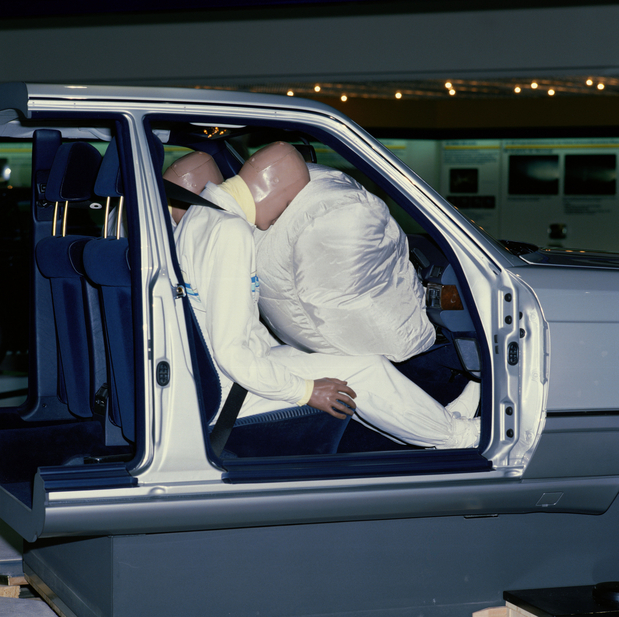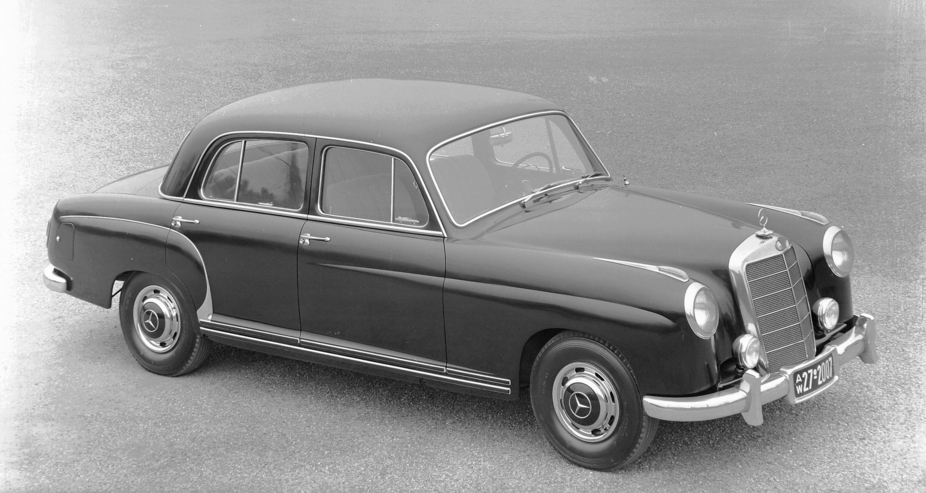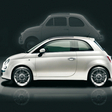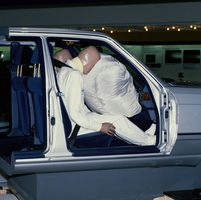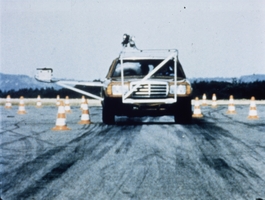|
Send this page to a friend! Fill in the form bellow | ||
news
Mercedes Celebrates 25th Anniversary of Passenger Airbag
© photo courtesy of: Mercedes-Benz
*Updated to reflect misinterpreted image.
Mercedes Mercedes-BenzGermany, 1924 > present197 models
Mercedes-BenzGermany, 1924 > present197 models
9852 photos
33 videos
introduced its first optional airbag on the W126 S-Class![S-Class Gen.2 [W 126/ V 126] S-Class Gen.2 [W 126/ V 126]](/img/series/58/mercedes_benz_s_class_gen_1_sqr112_2358.jpg) Mercedes-Benz S-Class Gen.2 [W 126/ V 126]Germany, 1979 > 199183 versions
Mercedes-Benz S-Class Gen.2 [W 126/ V 126]Germany, 1979 > 199183 versions
28 photos
in 1981. It was the first drivers-only airbag in the world to be offered in a production car. In 1987, Mercedes introduced the passenger airbag as an option in the W126 S-Class.
The original 1981 airbag system from Mercedes cost 1525.50 Deutsch Marks or €779.98 in today's money, but Mercedes has begun developing the system in the mid-1960s. While the driver's airbag could be housed in the steering wheel, the first passenger airbags from Mercedes took up the entire glove box. For 1988, Mercedes began offering the driver's airbag on the smaller W124 E-Class Mercedes-Benz E-Class Gen.2Germany, 1984 > 1995321 versions
Mercedes-Benz E-Class Gen.2Germany, 1984 > 1995321 versions
292 photos
, and in 1994 airbags became standard on all Mercedes.
Airbags were first offered in production cars by General Motors GMUnited States of America, 1998 > present8 models
GMUnited States of America, 1998 > present8 models
240 photos
as an option on full-size 1974 Cadillac CadillacUnited States of America, 1902 > present79 models
CadillacUnited States of America, 1902 > present79 models
1234 photos
2 videos
, Buick BuickUnited States of America, 1903 > present68 models
BuickUnited States of America, 1903 > present68 models
483 photos
1 video
and Oldsmobile OldsmobileUnited States of America, 1897 > 200425 models
OldsmobileUnited States of America, 1897 > 200425 models
115 photos
models. The system was odd by today's standards because it deployed from the center and protected both the center and right-most passenger driver and center passenger. The driver other passenger has his or her own airbag. You can view a diagram of the system used by Oldsmobile here.
The Generations of the Mercedes S-Class
The S-Class story begins officially with the W 116 in 1972. It was the first to be given the model designation but the history of the S-Class actually goes back much further. The following gallery includes also those models that laid the foundations for the post-war tradition of the great Mercedes-Benz premium-class saloons.Mercedes-Benz W 187: 1951 - 1954
In April 1951, Daimler-Benz debuted the 220 and 300 models at the first Frankfurt International Motor Show (IAA). The 220 was almost entirely based on the 170 S, only its 2.2-liter engine with 80 hp (59 kW) differed. The chassis and bodywork were almost identical, apart from the now integrated headlamps and new front fenders. The 220 saloon was produced until May 1954.Mercedes-Benz W 180/105/128: 1954 - 1959
Mercedes-Benz then introduced a new 220 model in 1954. The design was modernized and reminiscent of the 180 model. The 200 now featured a self-supporting ponton-type body structure welded to the frame/floor unit. It was the first Mercedes-Benz production car with a single-joint swing axle with low pivot point, which had been developed for the W 196 Formula One racing car.Mercedes-Benz W 111/112 series: 1959 - 1968
In August 1959, three redesigned models were launched: the 220 b, 220 Sb and 220 SEb. They offered improved passive safety, using the Barényi-patented rigid passenger cell. In August 1961, the new premium-class 300 SE model was introduced. The basic equipment package included air suspension – featured for the first time in a Mercedes-Benz passenger car.Mercedes-Benz W 108/109 series: 1965 - 1972
In 1965, the next generation included the 250 S, 250 SE and 300 SE models. In 1966, the model range was expanded to include the 300 SEL with a longer wheelbase. Production ended early in 1968 and the successor models 280 S and 280 SE were launched with new engines and equippment. Production of the W 108/109 model series came to an end in September 1972.Mercedes-Benz S-Class, W 116: 1972 - 1980
The first S-Class succeeded the W 108/109 series and included the 280 S, 280 SE and 350 SE, later joined by the 450 SE and 450 SEL. For the first time standard was the double-wishbone front suspension with zero-offset steering and anti-dive control, which was tested in the C 111. In 1978, the S-Class saloons became the first vehicles in the world equipped with ABS.Mercedes-Benz S-Class, W 126: 1979 - 1991
In 1979, Mercedes-Benz presented a new generation of the S-Class. Impovements were made in terms of aerodynamics and safety. From 1981 an airbag was available for the driver and from 1985 for the front passenger as well. After 12 years, 818,036 saloons had been produced, making it the most successful premium-class model series in company history.Mercedes-Benz S-Class, W 140: 1991 - 1998
In 1991, Mercedes introduced the third S-Class. It had a newly developed double wishbone front axle, improved ride comfort, a new 6.0-liter V12 engine. From 1996 the S 280 and S 320 models with automatic transmission offered the Electronic Stability Program ESP® and Brake Assist BAS became available. By 1998, a total of 406,532 saloons had been built.Mercedes-Benz S-Class, W 220: 1998 - 2005
The 4th S-Class came in 1998 with more than 30 new developments, including automatic cylinder shut-off, autonomous intelligent cruise control and a preventative occupant protection system. 2002, electronically-controlled all-wheel drive was available. Production of the W 220 ended in 2005 and a total of 484,683 saloons had been produced.Mercedes-Benz S Class, W221 series: since 2005
The 5th, and current, generation of the S-Class was launched in 2005 at the IAA. It is slightly larger than the previous and came with three new engines with a 26% power increase. It is offered in several different models that include the S250, the S350, the S400 Hybrid, S500, S63 AMG and S65 AMG.The United States was actually the cause of Mercedes beginning to develop airbags in the beginning. It had appeared that automatic driver safety systems would become mandatory in 1969 and this spurred airbag development.
The first airbags were quite dangerous. The experimental units developed by GM were used without seat belts and caused seven fatalities in testing. From these disastrous results, Mercedes and others began to develop airbags that had to be used in addition to seat belts. Mercedes filed the patent for its airbag in October 1971 that used sensors to ignite a nitrogen canister that filled a woven container folded into the steering wheel.
Once frontal airbags become standard, engineers began applying the technology to other areas. Side airbags became an option on the E-Class Mercedes-Benz E-Class Gen.3Germany, 1995 > 2003104 versions
Mercedes-Benz E-Class Gen.3Germany, 1995 > 2003104 versions
107 photos
in 1995.
Encyclopedia |
2 comments
Contribute
more about Mercedes-Benz



latest news




